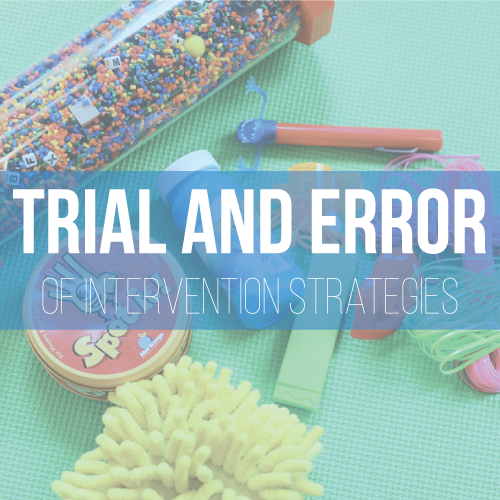The Trial and Error of Intervention Strategies
By Rachel Carpenter
We had a diagnosis: sensory processing disorder or SPD. I knew the technical term for this, and I knew that this meant that my daughter Addison received and interpreted senses differently than what I would expect. I knew that we would be spending a great deal of time with specialists, occupational therapists, ENT doctors, and school interventionists in our future. In reality, what lay ahead of us was a lot of trial and error in our attempts to find intervention and coping strategies for Addison.
Treatment for SPD generally begins with an occupational therapist to work on retraining the senses or finding coping methods for different sensory inputs and responses. According to ADDitudeMag.com, these professionals use sensory integration in a controlled environment to work with the patient and extend these practices to home, school, and daily life. Since every person with SPD is different, this means that therapy is a method of trial and error to find what works best for each individual. Occupational therapists use all their knowledge and tools to help patients and parents, and their patience knows no bounds.
I began Addison’s sessions with optimism and excitement. We were going to find ways to help her! We had some amazing professionals and so much support! Things were going to get so much better!
Oh, the naivety of the overwhelmed parent…I said that the therapy is a method of trial and error, and Addison’s therapy sessions felt more like failures than successes.
The first challenge was communication. She was two years old, but she was also behind in her speech and communication skills. It was difficult for her to tell us what she liked and disliked; what hurt or felt pleasurable; if something bothered her or excited her. We saw the obvious cues of screaming or running away, but these were also the cues we were trying to change.
The second challenge was in finding something, anything, that Addison would try. We tried weighted blankets and toys to encourage her to remain still and to provide compression, and she hated it. We used sensory bins to play hide-and-seek with favorite toys, a way to encourage tactile stimulation, and she would refuse to stick a finger in the rice bin. Her therapist created obstacle courses to challenge Addison in new textures and tasks, and she would quit halfway through. Her speech therapist had trouble finding ways to engage her, and she was uncooperative during group activities designed to help children like her to socialize and normalize behaviors.
My most vivid memory of this time is of the quiet area. Addison seemed to really respond to the quiet, tented area at her occupational therapist’s office. It was filled with soft pillows and low lighting, and the area was tucked behind a desk area as a rest place. She loved going there during sessions, so much so that it was used as a reward for completing other tasks. Her therapist suggested I make one at our house. I had a perfect place (behind the recliner chair, where she liked to hide anyway). I covered it with a canopy, filled it with one of her favorite blankets and stuffed animals, and I moved any lamps away from the area. I was excited to have a place for her in the house, and she seemed to share that sentiment. This was short-lived; something about this area did not agree with her, and Addison destroyed her quiet area the first time she used it. I was frustrated, but trial and error, right?
We did eventually find things that worked for Addison. She initially hated being restrained but with the right kind of pressure of a hug and soothing words, we found that her anger and screams could be quelled. We quickly learned that routines were her best strategy. We did the same things every day, in the same order and manner. I would talk to her the night before and during the day of every place we would be visiting, every task to be completed, and every expectation for the day and for Addison. It sounds tedious, and it definitely was, but it worked. We also had to know our limits. There was only so much stimulation that Addison could handle, and if that meant I had to say no to a playdate or to an event, I did. I had to remember that it would not always be this way but that for now, finding a way to help Addison and to integrate these strategies and coping methods into daily life was more important.
We were fortunate in that the therapists and support services we used were very aggressive. Addison was able to attend occupational therapy and group therapy each week, speech therapy every other week, and a larger support playgroup at least once a week. It was exhausting at times, and I often cried in frustration and helplessness during our sessions. Yet without it, I do not know where Addison would be now.
It was a difficult journey in our trial and error of intervention strategies but ultimately worth it. I began to understand my child and the human body in new ways. Both Addison and I were challenged daily in how to navigate the world through her eyes, ears, and mind. It seemed that for every success, we had at least five failures behind it. But we focused on the success and the things that worked to help Addison live with SPD. We still use many of the strategies and coping methods today, and we are finding more research and ways to aid her in school, home, and daily life. Trial and error it was…but if anything can help your child live a better life, it is a trial and error worth taking.

